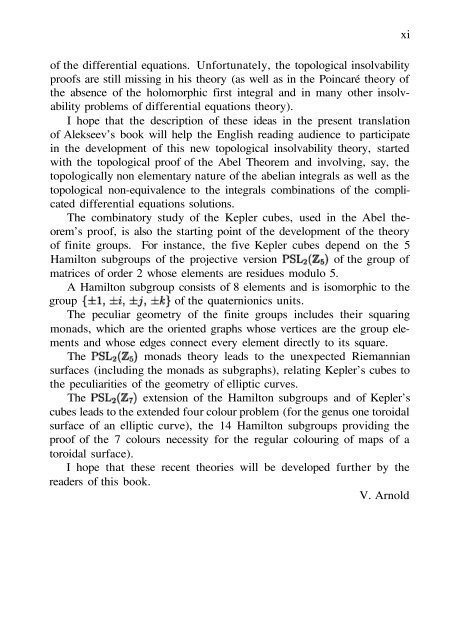Abel's theorem in problems and solutions - School of Mathematics
Abel's theorem in problems and solutions - School of Mathematics
Abel's theorem in problems and solutions - School of Mathematics
Create successful ePaper yourself
Turn your PDF publications into a flip-book with our unique Google optimized e-Paper software.
<strong>of</strong> the differential equations. Unfortunately, the topological <strong>in</strong>solvability<br />
pro<strong>of</strong>s are still miss<strong>in</strong>g <strong>in</strong> his theory (as well as <strong>in</strong> the Po<strong>in</strong>caré theory <strong>of</strong><br />
the absence <strong>of</strong> the holomorphic first <strong>in</strong>tegral <strong>and</strong> <strong>in</strong> many other <strong>in</strong>solvability<br />
<strong>problems</strong> <strong>of</strong> differential equations theory).<br />
I hope that the description <strong>of</strong> these ideas <strong>in</strong> the present translation<br />
<strong>of</strong> Alekseev’s book will help the English read<strong>in</strong>g audience to participate<br />
<strong>in</strong> the development <strong>of</strong> this new topological <strong>in</strong>solvability theory, started<br />
with the topological pro<strong>of</strong> <strong>of</strong> the Abel Theorem <strong>and</strong> <strong>in</strong>volv<strong>in</strong>g, say, the<br />
topologically non elementary nature <strong>of</strong> the abelian <strong>in</strong>tegrals as well as the<br />
topological non-equivalence to the <strong>in</strong>tegrals comb<strong>in</strong>ations <strong>of</strong> the complicated<br />
differential equations <strong>solutions</strong>.<br />
The comb<strong>in</strong>atory study <strong>of</strong> the Kepler cubes, used <strong>in</strong> the Abel <strong>theorem</strong>’s<br />
pro<strong>of</strong>, is also the start<strong>in</strong>g po<strong>in</strong>t <strong>of</strong> the development <strong>of</strong> the theory<br />
<strong>of</strong> f<strong>in</strong>ite groups. For <strong>in</strong>stance, the five Kepler cubes depend on the 5<br />
Hamilton subgroups <strong>of</strong> the projective version <strong>of</strong> the group <strong>of</strong><br />
matrices <strong>of</strong> order 2 whose elements are residues modulo 5.<br />
A Hamilton subgroup consists <strong>of</strong> 8 elements <strong>and</strong> is isomorphic to the<br />
group <strong>of</strong> the quaternionics units.<br />
The peculiar geometry <strong>of</strong> the f<strong>in</strong>ite groups <strong>in</strong>cludes their squar<strong>in</strong>g<br />
monads, which are the oriented graphs whose vertices are the group elements<br />
<strong>and</strong> whose edges connect every element directly to its square.<br />
The monads theory leads to the unexpected Riemannian<br />
surfaces (<strong>in</strong>clud<strong>in</strong>g the monads as subgraphs), relat<strong>in</strong>g Kepler’s cubes to<br />
the peculiarities <strong>of</strong> the geometry <strong>of</strong> elliptic curves.<br />
The extension <strong>of</strong> the Hamilton subgroups <strong>and</strong> <strong>of</strong> Kepler’s<br />
cubes leads to the extended four colour problem (for the genus one toroidal<br />
surface <strong>of</strong> an elliptic curve), the 14 Hamilton subgroups provid<strong>in</strong>g the<br />
pro<strong>of</strong> <strong>of</strong> the 7 colours necessity for the regular colour<strong>in</strong>g <strong>of</strong> maps <strong>of</strong> a<br />
toroidal surface).<br />
I hope that these recent theories will be developed further by the<br />
readers <strong>of</strong> this book.<br />
V. Arnold<br />
xi

















